
Janus Genelli (1761, Copenhagen - 1813, Berlin) was a German painter of Italian descent. He specialized in Classical landscapes.

Janus Genelli (1761, Copenhagen - 1813, Berlin) was a German painter of Italian descent. He specialized in Classical landscapes.
He came from a family of artists that originated in Rome. Around 1730, for unknown reasons, they emigrated to Denmark and settled in Copenhagen. His father, Joseph, worked as a silk knitter and embroiderer. They moved again in 1774, emigrating to Berlin by way of Vienna, to assist Frederick the Great in establishing a tapestry school.
It was there, around 1780, that he became a student of Blaise Nicholas Le Sueur, Director of the Academy of Arts. In 1786, he took a study trip to Rome, via Dresden, with his brother, the architect Hans Christian Genelli . There, he became acquainted with Jakob Philipp Hackert, who had a significant influence on his landscape style. [1]
From 1803, he served as a drawing teacher for Queen Luise von Preußen and Crown Prince Friedrich Wilhelm, who was then only eight years old. [2]

His works depict an ideal nature, with warm colors, even when dealing with dark subjects. Among his best works are his depictions of the Harz region and its mountains. His total output was rather small, and mostly unfamiliar today. It seems, however, that his works were highly regarded by his contemporaries.
He was the father of Bonaventura Genelli, a well-known painter and graphic artist.
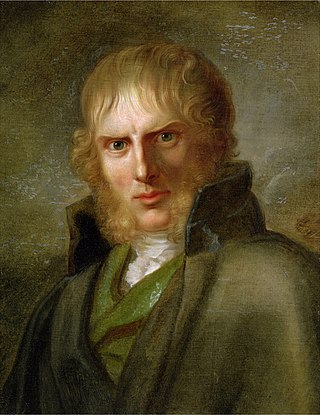
Caspar David Friedrich was a German Romantic landscape painter, generally considered the most important German artist of his generation. He is best known for his allegorical landscapes, which typically feature contemplative figures silhouetted against night skies, morning mists, barren trees or Gothic ruins. His primary interest was the contemplation of nature, and his often symbolic and anti-classical work seeks to convey a subjective, emotional response to the natural world. Friedrich's paintings characteristically set a human presence in diminished perspective amid expansive landscapes, reducing the figures to a scale that, according to the art historian Christopher John Murray, directs "the viewer's gaze towards their metaphysical dimension".
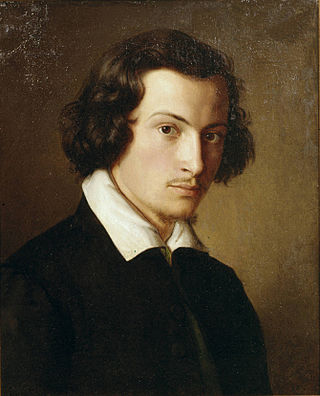
Philipp Veit was a German Romantic painter and one of the main exponents of the Nazarene movement. It is to Veit that the credit of having been the first to revive the nearly forgotten technique of fresco painting is due.
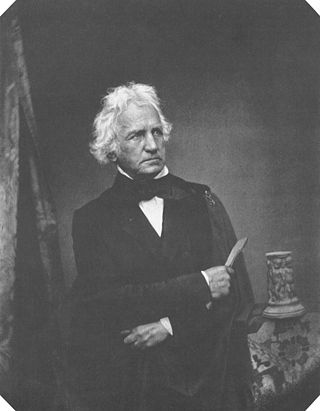
Christian Daniel Rauch was a German sculptor. He founded the Berlin school of sculpture, and was the foremost German sculptor of the 19th century.

Christoffer Wilhelm Eckersberg was a Danish painter. He was born in Blåkrog in the Duchy of Schleswig. He went on to lay the foundation for the period of art known as the Golden Age of Danish Painting, and is referred to as the "Father of Danish painting".
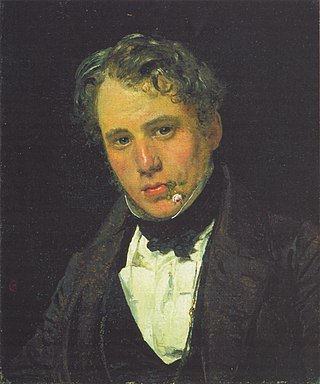
Nicolai Wilhelm Marstrand, painter and illustrator, was born in Copenhagen, Denmark, to Nicolai Jacob Marstrand, instrument maker and inventor, and Petra Othilia Smith. Marstrand is one of the most renowned artists belonging to the Golden Age of Danish Painting.

Martinus Christian Wesseltoft Rørbye was a Danish painter, known both for genre works and landscapes. He was a central figure of the Golden Age of Danish painting during the first half of the 19th century.

Johan Christian Claussen Dahl, often known as J. C. Dahl or I. C. Dahl, was a Danish-Norwegian artist who is considered the first great romantic painter in Norway, the founder of the "golden age" of Norwegian painting. He is often described as "the father of Norwegian landscape painting" and is regarded as the first Norwegian painter to reach a level of artistic accomplishment comparable to that attained by the greatest European artists of his day. He was also the first to acquire genuine fame and cultural renown abroad. As one critic has put it, "J.C. Dahl occupies a central position in Norwegian artistic life of the first half of the 19th century.
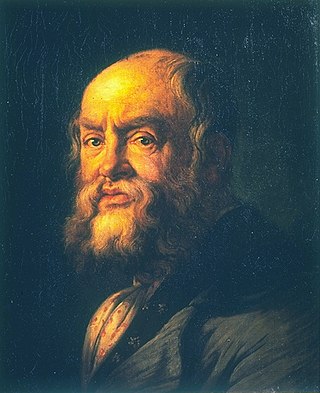
Giovanni Bonaventura Genelli was an Italian painter.

Karl Friedrich Lessing, also known by Carl Friedrich Lessing, was a German historical and landscape painter, grandnephew of Gotthold Ephraim Lessing and one of the main exponents of the Düsseldorf school of painting.

Christian Albrecht Jensen was a Danish portrait painter who was active during the Golden Age of Danish Painting in the first half of the 19th century. Painting more than 400 portraits over the course of his career, he depicted most of the leading figures of the Danish Golden Age, including the writer Hans Christian Andersen, the painter Christoffer Wilhelm Eckersberg, the sculptor Bertel Thorvaldsen, the physicist Hans Christian Ørsted and the theologian N. F. S. Grundtvig.

Carl Friedrich von Rumohr was a German art historian, writer, draughtsman and painter, agricultural historian, connoisseur of and writer about the culinary arts, art collector and patron of artists.

Maximilien de Meuron was a Swiss landscape painter in the Romantic style.

Friedrich (Fritz) Bury was a German artist born in Hanau. He studied first under his father Jean Jacques Bury, who was a goldsmith and professor in the Academy of Design in Hanau, and then with Johann Heinrich Wilhelm Tischbein. In 1780 he visited Düsseldorf, and two years later went to Rome; thence to Dresden, and finally settled in Berlin, where he was patronized by the Queen of Prussia. He painted historical pictures and portraits. A 'Cupid triumphant' by him is in the Hague Gallery.

Adolph Friedrich Vollmer was a German landscape and marine painter and graphic artist. He and his contemporary, the painter Christian Morgenstern, were pioneers in Hamburg of early Realism in painting.

Oskar Begas was a German portrait and history painter.
Wilhelm Schmidthild was a German painter, graphic artist, illustrator and art professor. He chose as his field detailed documentation as an illustrator for botanical and zoological reference books and free compositions in the tradition of realism. He is also known as Schmidt-Hild.

Rudolph Friedrich Miess was an Imperial Austrian-born painter from the Transylvania region, today part of Romania. Although he did numerous portraits, he is best known for his landscapes, which combine the Academic and Impressionist styles.

Ascan Lutteroth was a German landscape painter; associated with the Düsseldorfer Malerschule.

The Temple of Juno in Agrigento is an 1828-1830 oil on canvas painting of by Caspar David Friedrich. It is now in the Museum für Kunst und Kulturgeschichte in Dortmund, which bought it from a Cologne art dealer in 1951. It is said to have been previously owned by the F. A. Brockhaus publishers in Leipzig.
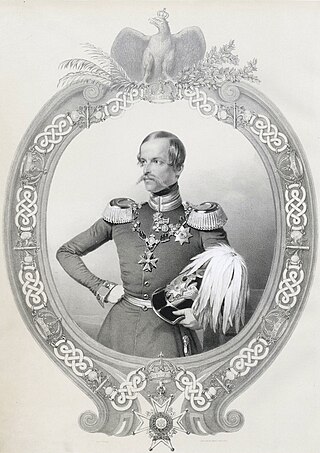
Prince Waldemar of Prussia was a son of Prince Wilhelm of Prussia and Landgravine Marie Anna of Hesse-Homburg. He was a Major general in the Prussian Army and a traveller.
![]() Media related to Janus Genelli at Wikimedia Commons
Media related to Janus Genelli at Wikimedia Commons